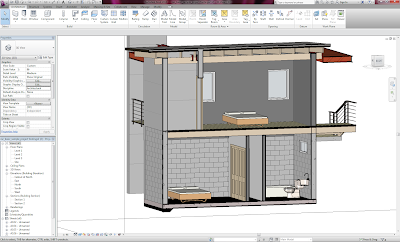The feedback included:
- There needs to be a steel structure supporting the roof
-There needs to be pad footings for the existing steel columns and beams as they are sitting on the ground. ( 1000x1000x500mm 500mm below ground level
- The concrete slab on the ground floor needs to be extended under the fireplace
-Strip drain for the house retaining walls, with Blue metal back fill
- 30 degree batter from the top of the footing
-Waterproof member needs to be placed on all walls under ground level
-Research Nylex Strip Drain
-Dry Wall for the interior walls as moisture is going to be a major issue.
-Adjust strip footings, at the moment there is a strip footing then peirs then an edge beam and slab- This design is pointless
-Hyspan, look at the span tables as this product is mostly used in the construction industry
The minutes..
BIM Modelling-
Image01: I have remodelled the sample model sub floor to suit the standard retaining/ footing detail (image02) The blockwork walls will be tied in with concrete footings and slabs.
Image02: a typical retaining wall detail where our site has a 2000mm height making our strip footing 1400x650x450 with standard N20-400.
Image03: This is a long section cut through the building showing the new designed slab floor
Image04: A cross section, walls need to be adjusted so the concrete block walls start flush with the strip footings.
Image05: The blockwork modified up to level 2, windows need to be adjusted.
Image06: need to model pad footings for the steel support structure.
Image07: Windows are placed and adjusted as they were within the ground line.
Image08:I have modelled the pad footings for the support stuctures which include 1000x1000x500mm. As steel and timber structural posts cannot be placed into the ground without foundations.
Image09: another view
Image10: section cut showing the new strip and pad footings.
Image11: A construction detail I drew a few years back. This detail can be used to help model the timber skillion roof which meets a brick veneer construction.
Image12: I have modelled in a Dry wall (timber frame) with a 50mm cavity of the blockwork walls. This will pretect the interior of mould and moisture as the blockwall is retaining soil, moisture is likely to be present.
Image13: I have lined up the ground floor timber walls with the first floor timber walls. The cavity air gap for this level is 140mm. Need help to determine construction detail, need wall ties and a waterproofing strategy for the timber frame.
Image14: i have modelled the connection where the concrete block walls meet the brick veneer.
Image15: Connection issue with the timber frame floor and wall (there needs to be a flashing for moisture) The timber floor construction could line up with the wall construction (but again waterproofing in the cavity needs to be considered. Timber frame is easily damages if exposed to water




























